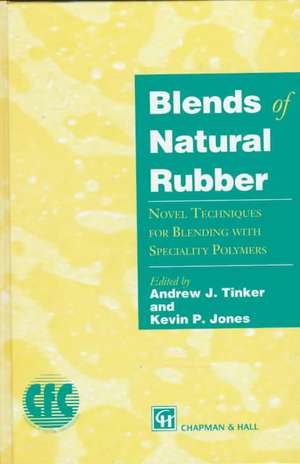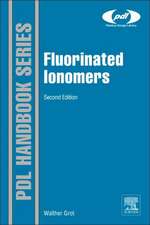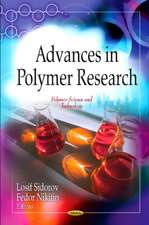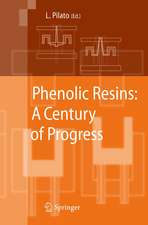Blends of Natural Rubber: Novel Techniques for Blending with Specialty Polymers
Autor K. C. Jones, Andrew Tinkeren Limba Engleză Hardback – 31 dec 1997
| Toate formatele și edițiile | Preț | Express |
|---|---|---|
| Paperback (1) | 943.57 lei 6-8 săpt. | |
| SPRINGER NETHERLANDS – 10 oct 2012 | 943.57 lei 6-8 săpt. | |
| Hardback (1) | 949.55 lei 6-8 săpt. | |
| SPRINGER NETHERLANDS – 31 dec 1997 | 949.55 lei 6-8 săpt. |
Preț: 949.55 lei
Preț vechi: 1157.98 lei
-18% Nou
Puncte Express: 1424
Preț estimativ în valută:
181.69€ • 190.39$ • 150.20£
181.69€ • 190.39$ • 150.20£
Carte tipărită la comandă
Livrare economică 11-25 aprilie
Preluare comenzi: 021 569.72.76
Specificații
ISBN-13: 9780412819407
ISBN-10: 0412819406
Pagini: 256
Ilustrații: XV, 256 p.
Dimensiuni: 155 x 235 x 18 mm
Greutate: 0.56 kg
Ediția:1998
Editura: SPRINGER NETHERLANDS
Colecția Springer
Locul publicării:Dordrecht, Netherlands
ISBN-10: 0412819406
Pagini: 256
Ilustrații: XV, 256 p.
Dimensiuni: 155 x 235 x 18 mm
Greutate: 0.56 kg
Ediția:1998
Editura: SPRINGER NETHERLANDS
Colecția Springer
Locul publicării:Dordrecht, Netherlands
Public țintă
ResearchCuprins
1 Introduction — the book and rubber blends.- 1.1 Sources of problems — and solutions.- 1.2 Blends considered.- 1.3 Strategy.- 1.4 Wider implications.- 2 Measurement of crosslink density in vulcanized blends.- 2.1 Swollen-state NMR spectroscopy.- 2.2 Network visualization microscopy.- 2.3 References.- 3 Characterization of vulcanized blends by microscopy.- 3.1 Introduction.- 3.2 Light microscopy.- 3.3 Scanning electron microscopy.- 3.4 Chemical staining.- 3.5 Chemical etching.- 3.6 Transmission electron microscopy.- 3.7 SEM-based scanning transmission electron microscopy.- 3.8 Conclusion.- 3.9 References.- 4 Estimation of crosslink density by solid-state NMR spectroscopy.- 4.1 Introduction.- 4.2 Experimental procedures.- 4.3 NMR spectra of NR.- 4.4 NMR spectra of other rubbers.- 4.5 Conclusion.- 4.6 References.- 5 NR/NBR blends — basic problems and solutions.- 5.1 Introduction.- 5.2 NR/NBR41.- 5.3 NR/Krynac 34.50 blends.- 5.4 Conclusion.- 5.5 References.- 6 Improving the morphology and properties of NR/NBR blends with NR/PMMA graft copolymers.- 6.1 Introduction.- 6.2 Methods of blending.- 6.3 Phase morphology.- 6.4 Physical properties.- 6.5 Crosslinking density distribution in the blends.- 6.6 Conclusions.- 6.7 References.- 7 Improving the morphology and properties of NR/NBR blends with polychloroprene as the compatibilizing agent.- 7.1 Introduction.- 7.2 Cure systems for NR/CR/NBR blends.- 7.3 Phase morphology of NR/CR/NBR blends.- 7.4 Conclusions.- 7.5 References.- 8 NR/NBR blends — compounding for food contact applications.- 8.1 Introduction.- 8.2 Formulations for milking inflations to meet FDA regulations.- 8.3 Formulations for milking inflations to meet BGA regulations.- 8.4 Conclusion.- 8.5 References.- 9 Novel natural rubber/ethylene propylene copolymer(EPM) blends.- 9.1 Introduction.- 9.2 Dynamic vulcanization.- 9.3 Selection of dynamic cure system.- 9.4 Dynamic vulcanization of NR/EPM blends.- 9.5 The sandwich mix cycle.- 9.6 Processing behaviour.- 9.7 Vulcanization of DV blends.- 9.8 Resistance to environmental damage.- 9.9 Preferred formulation.- 9.10 Conclusion.- 9.11 References.- 10 Natural rubber/ENR-25 blends.- 10.1 Introduction.- 10.2 Designed experiments.- 10.3 Plasticizer investigations.- 10.4 Cure systems.- 10.5 Dynamic:static modulus ratios.- 10.6 Tri-blends.- 10.7 Conclusions.- 10.8 References.- 10.9 Appendix.- 11 Partition coefficients for an ester plasticizer in black-filled blends.- 11.1 Introduction.- 11.2 Identification of exuding plasticizer.- 11.3 Estimation of Diolpate partition coefficients.- 11.4 Conclusion.- 11.5 References.- 12 Improving resistance to low temperature crystallization in NR/ENR-25 blends.- 12.1 Introduction.- 12.2 Effect of incorporating Hv-BR into NR/ENR-25 blends.- 12.3 Curative level optimization.- 12.4 Conclusions.- 12.5 References.- 13 Compounding NR/ENR-25 and NR/Hv-BR/ENR-25 blends for engineering applications 158.- 13.1 Introduction.- 13.2 Optimizing plasticizer level and masterbatch ratio.- 13.3 Mixing trials.- 13.4 Single-stage mixing for crossblending and finalizing.- 13.5 NR/Hv-BR/ENR-25 blends.- 13.6 Injection moulding.- 13.7 Conclusions.- 13.8 References.- 14 Solutions to the basic problems of poor physical properties of NR/EPDM blends.- 14.1 Introduction.- 14.2 Approaches to improving NR/EPDM blend properties.- 14.3 Mixing procedures.- 14.4 Effect of EPDM modification on crosslink density.- 14.5 Effect of EPDM modification on phase morphology.- 14.6 Interaction of modified EPDM and carbon black.- 14.7 Physical properties.- 14.8 High temperature curing effects.-14.9 Modification of different EPDM grades.- 14.10 Conclusion.- 14.11 References.- 15 Compounding NR/EPDM blends for tyre sidewalls.- 15.1 Introduction.- 15.2 Properties of comparable NR/BR and NR/EPDM blend formulations.- 15.3 Development of a NR/EPDM sidewall formulation.- 15.4 Experimental design approach.- 15.5 Crack growth testing.- 15.6 Large-scale factory mixing trials.- 15.7 Compound extrusion and tyre building.- 15.8 Initial tyre tests.- 15.9 Analysis of initial tyre testing.- 15.10 Second factory tyre building and testing trials.- 15.11 Ozone and atmospheric weathering tests.- 15.12 Conclusion.- 15.13 References.- 16 Compounding NR/EPDM blends for light-coloured applications.- 16.1 Introduction.- 16.2 General experimental procedures.- 16.3 Preparation of blend compounds.- 16.4 Comparison of physical properties.- 16.5 Formulation development.- 16.6 Weathering and ozone testing.- 16.7 Conclusion.- 16.8 References.- 17 NR/EPDM blends for extruded profile weatherstrip.- 17.1 Introduction.- 17.2 General experimental procedures.- 17.3 Initial preparation and assessment of blend compounds.- 17.4 Small-scale extrusion trials.- 17.5 Formulation development and processing.- 17.6 Conclusion.- 17.7 References.













